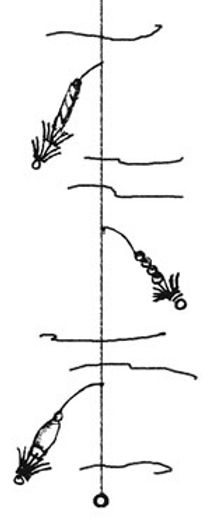Tripatini
the world's smartest travel social network
How To Fish For Squid
Squid fishing techniques
Odds of catching a squid are more favorable during high tide on a cloudy or rainy night. These conditions give the nearshore water the depth that squid prefer plus a setting in which the artificial light will be most noticeable.
In many areas, a single lure works best. For example, at Edmonds, most of the successful anglers use a single lure. The tall pole lights at the Edmonds pier shine farther out into the water meaning that you need to cast your lure farther out.
In other places, multiple lures (up to four) are better. By putting lures of different sizes and colors on the line anglers can test which type is attractive to the squid at that site, that night, at that time.

Anglers should also experiment with the arrangement of the set of lures. Sometimes putting the same lures in different order on the line makes a difference.
A favorite method of setting up with three lures is to space four-inch dropper lines 16 inches apart on the main line. Then add a one-ounce weight to the end of the main line.

Jigging
Single lure: If using a single lure, cast it out some distance from the dock (or boat or bulkhead) and allow it to sink to a depth where the squid may be lurking. Retrieve it with a series of steady jerks or "jigs."
Multiple lures: If using multiple lures, drop them into the lighted area of the water. Lower them down to the chosen depth (which frequently is just off bottom) then slowly raise them up and down in the water column.
Again knowing how challenging squid can be, no one style of lure is a constant winner. The specific environmental conditions dictate what is going to work or isn't.
Depth: Depth is a critical factor in the pursuit of squid. Having jigs working at different depths often spells "luck" or lack of it for side-by-side anglers.
Keep in mind that squid are congregational beings and stay gathered in schools.
How to land a squid:
Squid hole up in the darkness near lighted water areas then lunge into the brighter arena when they see something that looks edible. They don't "bite," however. They deftly wrap their tentacles around their intended prey.
The feel: Squid are those ghost-like "streaks" in the water and it's good to keep their fleetness in mind. Squids propel themselves backward by forcibly expelling water through a tiny nozzle that is part of their anatomy. They also can swim backward and forward, using their fins.
When a slight change in the behavior of your gear is felt, jerk upward to set the hooks immediately. Then keep a steady upward motion when reeling or lifting the catch to the surface. The hooks on squid jigs are barbless and most of the time the squid isn't really hooked, only entwined in the prongs so any slack in the line will lose the catch.
Two words of caution
Squid have a defense mechanism - dark ink. They shoot the ink at intruders who come too close. In the water it is an effective defense that creates a cloud behind which the squid makes a quick getaway.
Don't be overly distressed about getting squid ink on your hands and clothes, however. Not surprisingly, the ink is water soluble and washes out if you act quickly before it dries.
A second note of caution is the possibility of bites. It's good to remember that these creatures do have a parrot-like beak. Although squid are not likely to bite at a lure, they can and do bite things like food and perceived enemies who are not alert.
Important rules
• Fish at night
• Select a location where a strong light shines into the water
• Try different depths
• Try different colors
• Keep your jig moving at all times
• Set the hook when you feel the slightest pull on your line
Videos
Groups
-
India
173 members
-
Tour Operators
873 members
-
Ireland
93 members
-
South Dakota
17 members
-
Azerbaijan
17 members
-
Shopping the World
55 members
-
Tech for Travel/Hospital…
87 members
-
Andorra
26 members
-
Online Corner
75 members
-
Minnesota
22 members
-
Backpackers & Hostels
84 members
-
Portugal
60 members
-
Turks and Caicos
26 members
-
Agritourism/Farmstays
72 members
-
Zambia
21 members
© 2025 Created by EnLinea Media.
Powered by
![]()
Badges | Report an Issue | Privacy Policy | Terms of Service
You need to be a member of Tripatini to add comments!
Join Tripatini